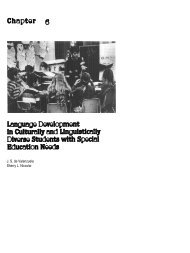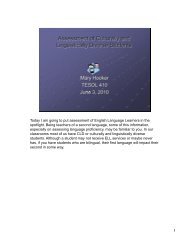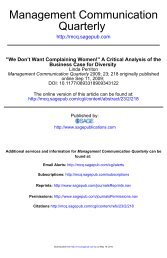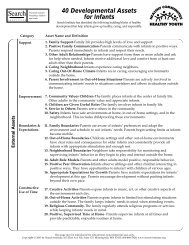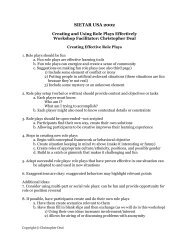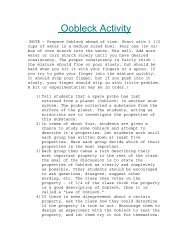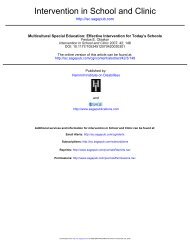Family Involvement for Culturally & Linguistically Diverse ...
Family Involvement for Culturally & Linguistically Diverse ...
Family Involvement for Culturally & Linguistically Diverse ...
You also want an ePaper? Increase the reach of your titles
YUMPU automatically turns print PDFs into web optimized ePapers that Google loves.
<strong>Family</strong> <strong>Involvement</strong> <strong>for</strong> <strong>Culturally</strong><br />
and <strong>Linguistically</strong> i i <strong>Diverse</strong>/<br />
Exceptional Learners<br />
Amy Mazur, EdD<br />
Tara Courchaine, MA<br />
Patricia Rice Doran, MA<br />
NATIONAL ASSOCIATION FOR BILINGUAL<br />
EDUCATION<br />
SPECIAL EDUCATION<br />
SPECIAL INTEREST GROUP MEETING<br />
FEB. 4, 2010<br />
DENVER, CO
Objectives<br />
By the end of the presentation, ,participants p will:<br />
• Describe the importance of family involvement <strong>for</strong><br />
culturally and linguistically diverse and/or<br />
exceptional (CLD/E) learners<br />
• Identify issues impacting family involvement <strong>for</strong><br />
diverse learners<br />
• Suggest schoolwide strategies to increase<br />
involvement <strong>for</strong> families of various backgrounds<br />
• Identify strategies <strong>for</strong> family involvement in the<br />
process of educational service delivery
Importance of family involvement <strong>for</strong> diverse<br />
learners<br />
• <strong>Family</strong> involvement has been shown to be key to<br />
educational success<br />
• Students who are CLD/E may need additional family<br />
support and advocacy to be successful in school<br />
• <strong>Family</strong> involvement essential from PK-12 and<br />
beyond<br />
• Students must pass high-stakes assessments and<br />
often benefit from family support
<strong>Family</strong> constellation<br />
• The meaning of “family” has changed dramatically in<br />
our society.<br />
• Rather than focus on “parent involvement,” schools<br />
must focus on involving significant adults in a child’s<br />
life, including extended d family members, caregivers,<br />
and even neighbors who provide support to students,<br />
whether their family constellation is traditional or<br />
nontraditional.
<strong>Family</strong> involvement: What the research says<br />
Research indicates:<br />
• <strong>Family</strong> involvement requires a partnership among<br />
families, schools, and communities (Epstein, 2008)<br />
• <strong>Family</strong> involvement can make a significant<br />
difference in academic achievement (Henderson and<br />
Mapp, 2002)<br />
• Schools must do a better job of responding to the<br />
needs of diverse learners and families (Snow, Barnes,<br />
Chandler, Goodman and Hemphill, 1991)
Funds of knowledge: a new way to look at<br />
family involvement<br />
• Funds of knowledge concept (Amanti, Moll, and<br />
Gonzalez, 2005): Schools should strive to see the<br />
student in the context of the varied experiences, life<br />
skills, and types of knowledge/ resources that t the<br />
student’s family can provide.<br />
• Example: A student’s s prior experience and family<br />
may provide him or her with: community support,<br />
resiliency, ability to make connections within the<br />
community, caring, strong intergenerational<br />
relationships. Each of these can impact school<br />
success positively. ii
Cultural context of family involvement<br />
• Educators must keep in mind that different cultures<br />
have different perceptions and norms <strong>for</strong> family<br />
involvement<br />
• <strong>Family</strong> involvement should not be viewed through a<br />
deficit model but through a cultural lens<br />
• Education happens in all aspects of a child’s life—so<br />
we should be wary of saying parents are “not<br />
involved in education” simply because they are not<br />
physically present at school<br />
• (Harry and Kalyanpur, 1999)
Issues impacting family involvement <strong>for</strong> diverse<br />
learners<br />
• Economic challenges<br />
• <strong>Family</strong> separation and reunification issues<br />
• Cultural differences and expectations <strong>for</strong> school<br />
environment<br />
• Linguistic differences and language acquisition<br />
• Immigration and legal issues<br />
• Geographical barriers (some districts send ELLs to<br />
cluster programs far from their neighborhood<br />
schools)
Increasing involvement on a schoolwide level<br />
• Strategies <strong>for</strong> increasing involvement on a<br />
schoolwide level must be responsive to the needs of<br />
the population of that particular school, at that<br />
particular time, given the economic, cultural, l and<br />
political realities of the moment.<br />
• Educators must rethink the concept of “parent<br />
involvement” or “family involvement” and, rather,<br />
value the involvement that family members already<br />
have<br />
• <strong>Family</strong> involvement may “look” different <strong>for</strong> diverse<br />
learners
Suggestions <strong>for</strong> teachers and administrators<br />
• Rethink your concept of family involvement<br />
• Get to know your school’s students and families<br />
• Be sure that communication is culturally and<br />
linguistically accessible and appropriate<br />
• Ensure family communication goes two ways<br />
• Provide venues <strong>for</strong> families to give feedback: open<br />
<strong>for</strong>um nights, surveys in backpacks, assignments <strong>for</strong><br />
students to interview i parents, etc.<br />
• Consider new ways to reach out to family members.<br />
(Some suggestions follow!)
Suggestions <strong>for</strong> reaching out to families<br />
• Develop a community resource list, providing names, contact<br />
in<strong>for</strong>mation, i and brief descriptions i <strong>for</strong> local l resources, social service<br />
agencies, and advocacy/ education organizations, and make it available<br />
in hard copy or online, in multiple languages .<br />
• Ak Ask students (or teachers) to put together a booklet, series of posters, or<br />
even a short video depicting a “day in the life” of the school, Such a<br />
resource could be used to share in<strong>for</strong>mation with families, who may not<br />
be familiar with school expectations, routines, and academic demands.<br />
• Ask students to work with their families to create a brochure, booklet,<br />
poster, oral retelling, or (if feasible) video depicting a “day in the life” of<br />
their family. Much like the school poster or video, this only allows<br />
students to develop fine arts, critical thinking, and storytelling skills,<br />
but it also provides a way <strong>for</strong> students and families to make school staff<br />
aware of their backgrounds. Children and families can make heritage<br />
boxes containing artifacts that represent their heritage and<br />
background.
Suggestions <strong>for</strong> reaching out to families<br />
• Students and families could also do a “heritage recording” using an<br />
audio or video recorder, recording a family member telling a story,<br />
videotaping a family event, or recording themselves discussing their<br />
heritage. Schools may wish to consider requesting support from a local<br />
merchant or foundation <strong>for</strong> purchasing cameras to lend to families.<br />
• Families can help children do family heritage timelines, using chart<br />
paper or sentence strips sent home from school. These, like the<br />
heritage box, would provide an opportunity <strong>for</strong> families to discuss their<br />
cultural background and heritage together and to identify particularly<br />
important events to be included on the timeline.
More suggestions <strong>for</strong> involving families<br />
• Families can record (or illustrate) their favorite fairy tale,<br />
poem, or song. The stories can be housed in the school media<br />
center or in each classroom. This activity, like the preceding<br />
ones, could easily be integrated into a language arts or social<br />
studies unit.<br />
• Develop “communication journals,” using pictures as well as<br />
words (or in place of words), in order to document<br />
improvements or report concerns or accomplishments at<br />
home.<br />
• Rather than asking families to support the school financially,<br />
which may be difficult <strong>for</strong> families of diverse students, schools<br />
can request that families contribute time to refurbishing the<br />
school facilities: paint, clean, replant/plant, sand tables, sew<br />
curtains, do light construction, and other activities which help<br />
to maintain the physical plant.
Further suggestions<br />
• To ensure all families are aware of the opportunities that are open to<br />
students at the school, school personnel can design and send a large<br />
post card home with in<strong>for</strong>mation about extracurricular options.<br />
Consider putting the words “For Free,” printed in different languages,<br />
on the postcard, and then including photos or graphics that illustrate<br />
the opportunities available in drama, music, sports, leadership<br />
positions, service, and other areas at the school. Consider including a<br />
contact number or email <strong>for</strong> a person who can put families in touch<br />
with the facilitator or coach <strong>for</strong> each activity.<br />
• Ask families where they would like to meet with school staff. Some<br />
families feel more com<strong>for</strong>table meeting on “neutral territory, ” or, in<br />
other words, in a location where they feel safe: where authorities are<br />
not present and where they know they will not be asked <strong>for</strong><br />
identification. Consider using a church center, community<br />
organization, mall, or community room in a local housing complex.
Model <strong>for</strong> helping provide teachers with skills<br />
to involve families<br />
• 18-credit and 45-credit professional development (PD)<br />
programs <strong>for</strong> teachers of CLD students<br />
• Coursework leads to MA or certificate<br />
• <strong>Family</strong> involvement themes and issues integrated<br />
across all courses<br />
• Practical assignments require teachers to create<br />
materials and resources that can be used to<br />
communicate with families<br />
• Project personnel available to support teachers in<br />
integrating ideas into practice
Ideas in Practice<br />
• Roberto Clemente High School, a school serving a<br />
highly diverse student body (including ELL students<br />
as well as those from other minority groups who<br />
were native speakers of English), decides to sponsor<br />
a “family night” to increase involvement of ELLs.<br />
The following steps were taken to ensure family<br />
attendance:<br />
• Pre-event consultation between ESOL, special<br />
education, and administration.<br />
• Dinner and childcare provided
Ideas in practice, continued<br />
• Survey of ESOL students and parents be<strong>for</strong>ehand to<br />
determine topics<br />
• Agenda and flyers disseminated in advance in<br />
multiple languages<br />
• Tables at event with interpreters (staff present to<br />
guide attendees to appropriate table based on<br />
language spoken)<br />
• Follow-up meeting among all stakeholders to debrief<br />
and make future plans (parents included in this<br />
group)
School-based Scenario<br />
• Luis is a second-grade teacher concerned about one<br />
student, Rosa, a second-language learner. Rosa<br />
misses school at least one day a week (or comes late).<br />
Based on her attire, Luis guesses her family is living i<br />
in poverty, and Rosa qualifies <strong>for</strong> the FARMS<br />
program. Her homework completion is infrequent<br />
(once a week on average). Luis has tried to send<br />
notes home and to call home, using the interpreter<br />
service available through the school, but has not<br />
been successful in getting through to a family<br />
member.
Questions to Consider<br />
• What next steps would you suggest as he seeks to<br />
increase involvement of Rosa’s family<br />
• How might Luis seek to involve Rosa and her family<br />
as equal partners in the educational process<br />
• What “funds of knowledge” might Rosa’s family<br />
bi bring to enrich ih her educational experience<br />
• How could Luis integrate family involvement themes<br />
into classroom activities without marginalizing those<br />
students who have nontraditional family structures<br />
and/or barriers to family involvement
References<br />
• Gonzalez. N., Moll, L. and Amanti, C. (eds.) (2005). Funds of knowledge: Theorizing practices in<br />
households, communities and classrooms. New York: Routledge.<br />
• Henderson, A. T., & Berla, N. (Eds.). (1994). A new generation of evidence: The family is critical to<br />
student achievement. Columbia, MD: National Committee <strong>for</strong> Citizens in Education. (ERIC Document<br />
No. ED375968) Retrieved September 15, 2006, from<br />
http://www.eric.ed.gov/ERICDocs/data/ericdocs2/content_storage_01/0000000b/80/23/60/0b.pd<br />
f<br />
• Henderson, A. T., & Mapp, K. L. (2002). A new wave of evidence: The impact of school, family, and<br />
community connections on student achievement. Austin, TX: National Center <strong>for</strong> <strong>Family</strong> and<br />
Community Connections with Schools, Southwest Educational Development Laboratory. Retrieved<br />
September 15, 2006, from http://www.sedl.org/connections/resources/evidence.pdf<br />
pdf<br />
• National Association <strong>for</strong> the Education of Young Children. (2002). Building parent-teacher<br />
partnerships. Washington, DC: Author. Retrieved September 15, 2006,<br />
fromhttp://www.naeyc.org/families/PT<br />
• Snow, C., Barnes, W., Chandler, J., Goodman, I., and Hemphill, L. (1991). Unfulfilled expectations:<br />
Snow, C., Barnes, W., Chandler, J., Goodman, I., and Hemphill, L. (1991). Unfulfilled expectations:<br />
Home and school influences on literacy. Cambridge, MA: Harvard University Press



